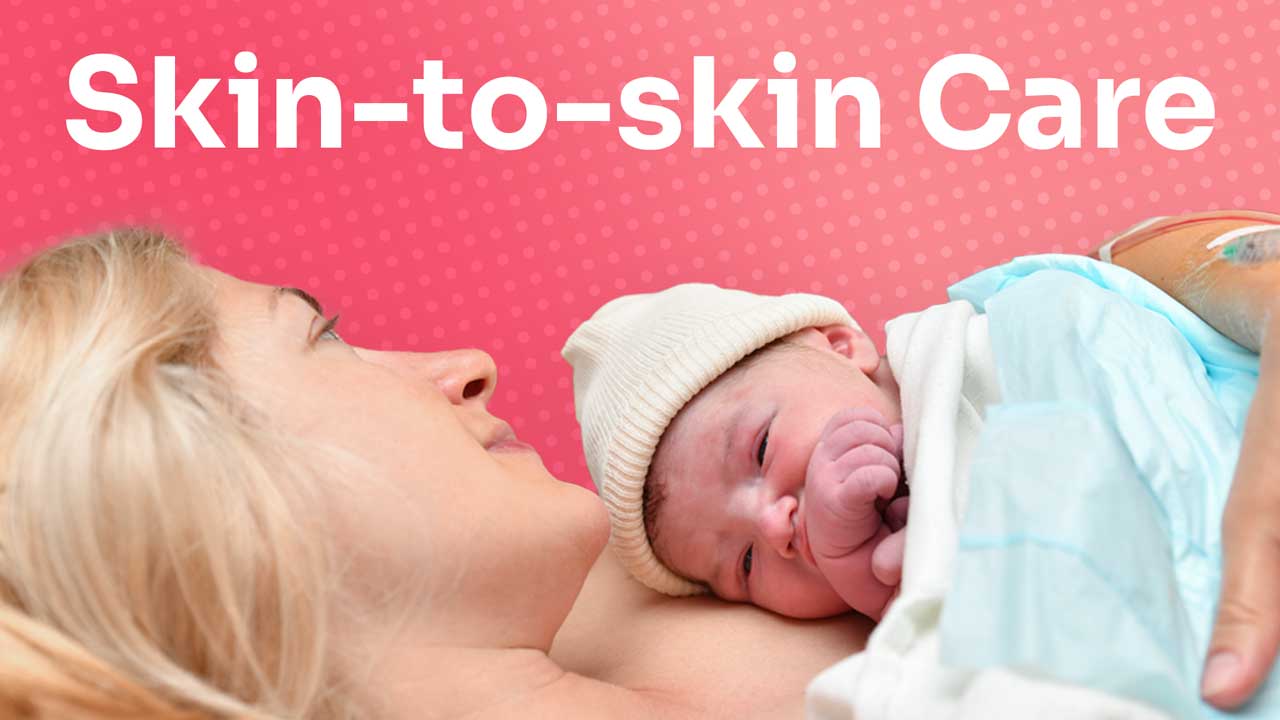Skin-to-skin care, also known as kangaroo care, has well-established benefits from the first moments of birth, through the neonatal period and beyond.
So, how can parents be helped to take full advantage of this practice, and what benefits can be gained?
What is Skin-to-skin Care?
Skin-to-skin care simply involves holding an infant in an upright, prone position, skin-to-skin on the parent’s chest. The parents’ clothing or blankets are then wrapped around the baby, providing a kangaroo-like pouch for comfort and security (RCHM 2023).
Improved breastfeeding and deeper levels of parental bonding and attachment are just a few of the important benefits of this contact.

The First Hour After Birth
Skin‐to‐skin contact should ideally begin at birth and last continually until the end of the first breastfeeding.
The intimate contact generated by placing the dried, naked baby prone on the mother's bare chest immediately after birth is known to evoke important neuro‐behaviours. It’s also thought that the time frame immediately post-birth may represent a sensitive period for programming future physiology and behaviour (Moore et al. 2016).
The practice of immediate or early skin-to-skin contact has been proven to have many benefits for both parent and baby, including:
Benefits for the parent:
- Earlier expulsion of the placenta
- Reduced bleeding
- Increased breastfeeding self‐efficacy
- Reduced stress.
Benefits for the baby:
- Decrease in the stress of being born
- Improved haemodynamic stability (e.g. thermoregulation and blood sugar levels)
- Regulation of vital signs
- Increased weight gain
- Decreased risk of infection
- Decreased risk of mortality
- Improved oxygen saturation levels
- Longer periods of quiet, calm sleep
- Easier breastfeeding
- Reduced stress and crying
- Lowered pain perception.
(Widström et al. 2019; RCHM 2023; Pregnancy, Birth and Baby 2023)
Early Skin-to-skin Care and Breastfeeding
It’s long been accepted that immediate, uninterrupted skin-to-skin care for a minimum of one hour is among the most effective strategies in maternity settings to promote exclusive breastfeeding (NICE 2017).
According to Crenshaw (2014), early skin-to-skin contact promotes the initiation of breastfeeding and protects against the negative effects of parent-baby separation.
As Widström et al. (2019) point out, breastfeeding reflexes ‘awaken’ during skin-to-skin care, with newborns exhibiting a specific sequence of behaviours that result in finding and attaching to their parent’s breast. They have also demonstrated that babies who have early skin-to-skin care are more likely to remain exclusively breastfed after discharge and breastfeed for longer durations of time.
Skin-to-skin care has also been shown to improve tolerance to painful procedures such as heel prick blood collections (Sharma & Ruikar 2022).
Non-birthing parents can also benefit. Chen et al. (2017) emphasise that skin-to-skin contact encourages exploring, talking, touching, and caring behaviours, helping to reduce parental anxiety while also enhancing the attachment process.
Skin-to-skin in Intensive Care
Skin-to-skin care can also offer significant benefits for babies who are born prematurely or require special and intensive care. As Lorenz et al. (2021) have discovered, there is no obvious reduction in oxygenation when babies are being nursed skin-to-skin compared to inside the incubator, suggesting that kangaroo care for babies needing intensive care is safe and should be encouraged.
Not all infants in intensive care can benefit, however. Babies who have an umbilical catheter in situ, who need, or are recovering from surgery, or whose condition is unstable may have to wait until their condition improves before skin-to-skin care becomes a safe option for them (RCHM 2023).
Benefits for the Parents
Enhanced parent-infant attachment and an increased parental ability to recognise their infant’s cues are just a few of the benefits that parents can gain from kangaroo care (RCHM 2023). Other advantages include:
- Enhanced bonding and emotional attachment
- Greater confidence in handling the baby
- Increased maternal milk production
- Decreased anxiety and depression.
(RCHM 2023)
Yet another benefit is revealed by the work of Kahalon et al. (2021), who have discovered that the association between skin-to-skin care and birth satisfaction is especially strong for parents who had operative births and specifically a caesarean birth. This suggests that the relationship between skin-to-skin contact and birth satisfaction should be emphasised, particularly after operative births.

Nursing Care
For vulnerable babies requiring special or intensive care, a nurse should always remain present in the room, and extra precautions should be taken before commencing skin-to-skin care, including:
- Checking that the baby’s temperature is stable and adding or removing hats and blankets as needed
- Ensuring the baby is nursed only in a nappy to maximise skin contact
- Confirming all monitoring alarms are audible and set within appropriate limits
- Ensuring patency and security of intravenous lines and monitoring equipment
- If the baby is intubated, ensuring that the endotracheal tube is secure and that breath sounds are equal before transfer.
(RCHM 2023)
The Long‐Term Benefits of Early Skin‐to‐skin Contact
In addition to the many short-term benefits of early skin-to-skin care, some important long-term benefits have been noticed as well.
For example, immediate skin‐to‐skin contact provides the initial colonisation of the baby's microbiome outside of the parent. It’s also been found that the parent’s breast temperature increases when the mother and newborn infant are in skin‐to‐skin contact, resulting in an increase in the infant’s foot temperature. This, in turn, indicates a decrease in the negative effects of the stress of being born. Parents who nurse their babies skin‐to‐skin after birth have also been observed to handle their babies more gently during the early days of breastfeeding and have an improved relationship with their babies within the first year of life (Widström et al. 2019).
Conclusion
The case for both short and long-term skin‐to‐skin care seems to be overwhelmingly positive. Perhaps, as Kahalon et al. (2021) recommend, maternity care providers should take whatever steps are necessary to facilitate skin-to-skin contact between the parent and their infant either immediately or as soon as possible after birth, whatever the method of delivery.
Topics
References
- Chen, E, Gau, M, Liu, C & Lee, T 2017, ‘Effects of Father-Neonate Skin-to-Skin Contact on Attachment: A Randomized Controlled Trial’, Nursing Research and Practice, viewed 25 July 2024, https://www.hindawi.com/journals/nrp/2017/8612024/
- Crenshaw, J 2014, ‘Healthy Birth Practice #6: Keep Mother and Baby Together— It’s Best for Mother, Baby, and Breastfeeding’, The Journal of Perinatal Education, vol. 23, no. 4, viewed 25 July 2024, https://connect.springerpub.com/content/sgrjpe/23/4/211
- Kahalon, R, Preis, H & Benyamini, Y 2021, ‘Who Benefits Most From Skin-to-Skin Mother-Infant Contact After Birth? Survey Findings on Skin-to-Skin and Birth Satisfaction by Mode of Birth', Midwifery, vol. 92, viewed 25 July 2024, https://www.sciencedirect.com/science/article/abs/pii/S0266613820302345?via%3Dihub
- Lorenz, L, Dawson, J, Jones, H, Jacobs, S, Cheong, J, Donath, S, Davis, P & Kamlin, C, 2021, ‘Skin-to-Skin Care in Preterm Infants Receiving Respiratory Support Does Not Lead to Physiological Instability’, BMJ, vol. 102, no. 4, 25 July 2024, https://fn.bmj.com/content/102/4/F339.abstract?papetoc=
- Moore, E, Bergman, N, Anderson, G & Medley, N 2016, ‘Early Skin-to-Skin Contact for Mothers and Their Healthy Newborn Infants’, Cochrane Database of Systematic Reviews, vol. 11, no. 11, viewed 25 July 2024, https://www.ncbi.nlm.nih.gov/pmc/articles/PMC6464366/
- National Institute for Health and Care Excellence 2017, Quality Statement 7: Skin-to-Skin Contact, NICE, viewed 25 July 2024, https://www.nice.org.uk/guidance/qs105/chapter/quality-statement-7-skin-to-skin-contact
- Pregnancy, Birth and Baby 2023, What is Kangaroo Care?, Healthdirect Australia, viewed 25 July 2024, https://www.pregnancybirthbaby.org.au/what-is-kangaroo-care
- The Royal Children's Hospital Melbourne 2023, Nursing Guidelines: Skin to Skin Care for the Newborn, RCHM, viewed 25 July 2024, https://www.rch.org.au/rchcpg/hospital_clinical_guideline_index/Skin_to_Skin_Care_for_the_Newborn/
- Sharma, H & Ruikar, M 2022, ‘Kangaroo Mother Care (KMC) for Procedural Pain in Infants: A Meta-Analysis From the Current Evidence of Randomized Control Trials and Cross-Over Trials’, Journal of Family Medicine and Primary Care, vol. 11, no. 4, viewed 25 July 2024, https://journals.lww.com/jfmpc/fulltext/2022/04000/kangaroo_mother_care__kmc__for_procedural_pain_in.5.aspx
- Widström, A, Brimdyr, K, Svensson, K, Cadwell, K & Nissen, E 2019, ‘Skin‐to‐Skin Contact the First Hour After Birth, Underlying Implications and Clinical Practice’, Acta Paediatrica, vol. 108, no. 7, viewed 25 July 2024, https://onlinelibrary.wiley.com/doi/full/10.1111/apa.14754
 New
New 
